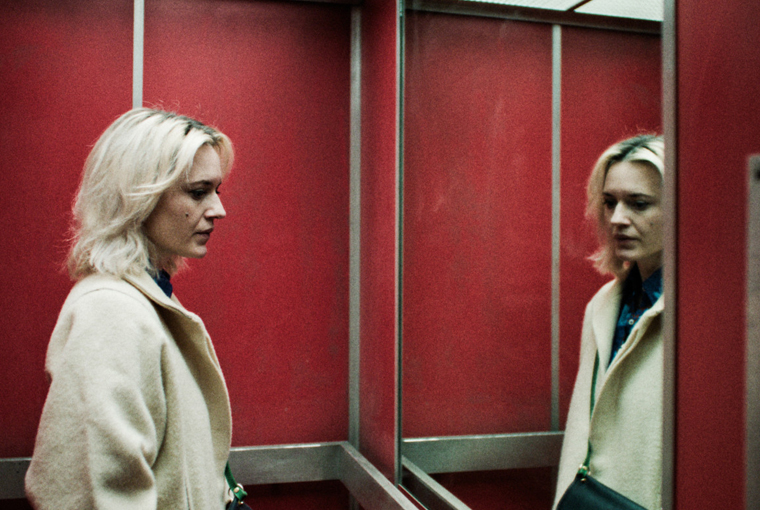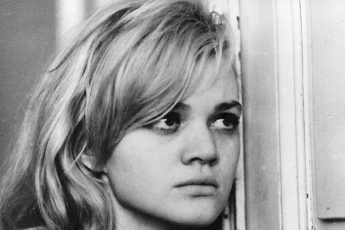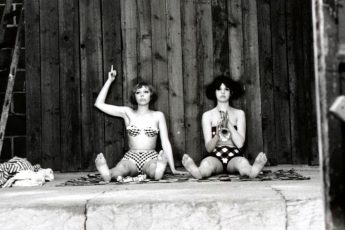A Mother Divided by Regimes and Trauma
Alexandra Makarová’s Perla (2025)
Vol. 158 (October 2025) by Martin Kudláč
Set in early 1980s Austria, Alexandra Makarová’s Perla follows the titular character, a Czechoslovak émigré, as she tries to build a new life for herself and her daughter after fleeing political repression. Suspended between systems, nations, and identities, Perla (played by Slovak actress Rebeka Poláková) lives with her daughter Julia (Carmen Diego) and new partner Josef (Simon Schwarz) in Vienna. She attempts to find a footing in an art community that feels simultaneously liberating and alien. Importantly, she appears to have escaped.
But the past intrudes in the form of a phone call from her daughter’s father Andrej (Noël Czuczor), still behind the Iron Curtain in Slovakia, and what follows is a slow unraveling of boundaries: between self and system, motherhood and autonomy, exile and return. Through precisely framed compositions and an austere storytelling structure, Perla captures the hard choices of not only immigration but motherhood.
The film opens with Julia taking piano lessons in Vienna, accompanied by Perla. The introduction presents Perla as a carefree mother and aspiring artist within the Viennese cultural scene. Her relationship with Julia is relaxed, even playful – at one point, she teases her daughter on a bus, to Julia’s quiet embarrassment. Perla appears free-spirited, unencumbered by bourgeois conventions, seemingly crafting a fairy-tale existence in exile with her partner, Josef. This delicate illusion is disrupted by a call from Andrej, who informs her he is terminally ill. The news compels Perla to take the risk of returning to her homeland, hoping to find closure with Andrej and to bury her parents. Yet the journey reveals the enduring distance, both emotional and political, between countries divided by the Iron Curtain.
Makarová constructs Perla’s motivation for returning home through a careful layering of personal history, her fractured identity, the memory of her parents, and the unresolved bond with Julia’s father. In a deliberate and striking narrative turn, she includes a scene depicting Perla and Andrej’s attempted escape from totalitarian Czechoslovakia. Their flight ends in capture, and the border patrol’s nighttime interrogation in an open field culminates in the rape of a pregnant Perla. The aftermath sees Andrej imprisoned, while Perla eventually succeeds in her second attempt to flee.
The sophomore feature of Slovak-born and Vienna-based Makarová explores womanhood from multiple angles through its non-conventional protagonist. Perla resists the 1980s expectations of domesticity and seeks a life beyond the confines of the dutiful housewife. While the film is primarily a period psychological drama, Perla’s decision to return to the oppressive Communist regime introduces a shift in tone. The story initially adopts a fish-out-of-water perspective, with Perla confronting, and at times bemused by, the cultural dissonance she encounters. One such moment is set in an eatery, where her eagerness to rediscover the long-forgotten dishes of her childhood contrasts sharply with the locals’ restrained, even resentful, attitudes shaped by scarcity and economic hardship.
Perla is met with disapproval even at her hotel, which, though relatively luxurious for a returnee, does little to shield her from the judgment of others. Upon her arrival, the film begins to navigate two primary sources of tension: the suspicion and hostility of her compatriots toward what they perceive as a brazen return under a false identity, and the increasingly fraught dynamic with Andrej, who proves not only manipulative but also driven by a desire for retribution. As these two threads converge, the film gradually adopts the tone of a Cold War–era quasi-spy thriller, as Perla is threading on dangerous ground literally and figuratively.
Makarová stages another unsettling scene, the first act of Andrej’s revenge, when he offers Perla to a group of men roaming a village during Easter festivities. They participate in a traditional ritual involving the whipping of women with willow branches and dousing them with cold water. In Makarová’s rendering, much like the earlier rape scene, the sequence unfolds at length in an oppressive atmosphere, exposing the ritual’s latent misogyny. As the dousing escalates, the act becomes increasingly violent. The director stylizes the moment into a haunting tableau, with the men in folkloric costumes appearing almost spellbound as they pursue Perla along a riverbank, ultimately subjecting her to a ritual that devolves into a form of torture. The scene crystallizes into a striking image: a group of men overpowering a defiant woman. It becomes a visual metaphor not only for the patriarchy and authoritarianism, but also for the entanglement of those forces with nationalism.
Makarová made her directorial feature debut in 2018 with Crush My Heart, a film that introduced her as a filmmaker attuned to themes of trauma, intergenerational memory, and familial dynamics. Perla continues along this trajectory. While less outwardly expressive than her earlier work, it is more formally assured and conceptually focused. Makarová remains concerned with the psychological toll of historical upheaval, but here she narrows the scope. The macro-historical is transposed into the domestic and corporeal, with a focus on women who resist the period’s norms and the prevailing social expectations of womanhood.
Shot with compositional rigidity by cinematographer Georg Weiss, Perla maintains a visual language that foregrounds detachment. Doors, windows, and mirrors are frequent motifs, dividing the frame, isolating characters, and evoking a world of spatial and emotional partitions. These visual separations mirror Perla’s own fragmented identity that is torn between two countries. The film avoids direct melodrama in favor of a more distanced, observational gaze, which the director stages within fixed shots. Scenes often play out in long takes, some bordering on static tableaux.
Though Perla is firmly set in a specific historical moment, the Cold War-era divide between East and West, it avoids period piece aesthetics. Rather than highlighting visual cues of the 1980s, Makarová reconstructs the era through texture and tone. The production design is minimal, avoiding retro signifiers. The color palette, influenced by Kodachrome’s saturated primaries, is subdued yet calculated. This approach de-emphasizes nostalgia and instead underlines the continuity between past and present.
Perla is grounded in ambivalence, particularly around the figure of the mother. The film’s most disquieting tension emerges not from the past that haunts Perla, but from her ambivalent role as both caregiver and autonomous subject. Rather than portraying motherhood as a site of sacrifice or virtue, Makarová allows her protagonist to be contradictory, at times withholding, at times impulsive. The film challenges normative expectations of maternal behavior and, in doing so, reveals viewers’ gendered assumptions.
Autobiographical elements run beneath the surface. Makarová, herself born in Slovakia and raised in Vienna, has spoken about the generational echoes of displacement in her family history, from Russian exile to Soviet-era migration. The personal is refracted through the fictional.
The film’s most potent sequences are those that disturb the viewer’s sense of narrative stability. A scene of sexual assault is filmed in real time but avoids conventional dramatization. It is neither graphic nor stylized, but matter-of-fact, which renders it more unsettling. Similarly, a folk Easter ritual unfolds with an atmosphere of quiet dread. These scenes locate horror not in the spectacular but in the banal.
Perla fits into a recent movement of Central and Eastern European cinema that reconsiders Socialist histories through a non-ideological, often gendered lens. Like the works of Teona Strugar Mitevska or Agnieszka Smoczyńska, the film navigates national memory through female subjectivity, but without aligning itself with any specific political position.
In Perla, Makarová continues to examine the psychological residues of historical trauma. The protagonist exists in a liminal space, caught between languages, loyalties, roles, and identities, yet the reckoning she faces is not of her own making. Perla becomes a target simply for attempting to live on her own terms, refusing to submit to a political regime or a single man’s authority.
While Makarová’s second feature is not an overtly feminist statement, it portrays a woman’s quiet resilience and determination, both as an individual and as a mother. The thriller-like formal approach does not diminish the story’s emotional weight. On the contrary, it anchors the story more firmly in its historical moment and reveals the underlying mechanics of totalitarian systems.
While (family) stories set during Communism remain a fixture in both Czech and Slovak cinema, female protagonists have not been so prominent, which makes Perla and its fusion of psychological drama with aspects of the thriller genre a refreshing change.




Leave a Comment